For woodworkers, a chisel is more than just a tool, it helps turn plain wood into beautiful projects. Whether you’re cutting joints or adding small details, the right chisel makes the job easier and more accurate.
This easy guide is made for beginners. You’ll learn about the different types of chisels, how to use them, what to look for when buying, and how to keep them sharp and clean. By the end, you’ll feel ready to use your wood chisels with confidence.
Table of Contents
What is a Wood Chisel?
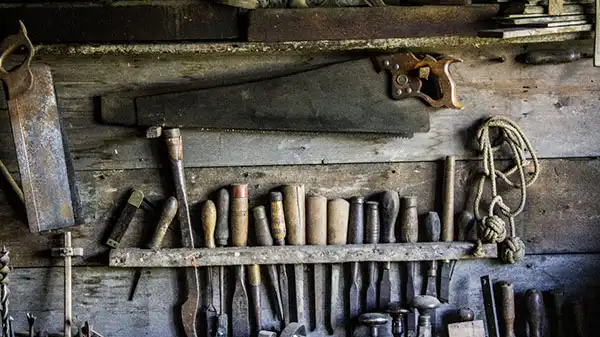
A wood chisel is a hand tool with a sharp metal blade and a handle, designed to carve, shape, or cut wood. Its versatility spans from roughing out material to fine detailing.
Brief History
Chisels date back to ancient Egypt, where they were used for stone and wood carving. Modern versions evolved in the 18th century with steel blades and ergonomic handles.
Why It Matters
Chisels are indispensable for joinery, sculpture, and furniture-making. Unlike power tools, they offer unmatched control for delicate work.
Related: Wood Chisel vs Cold Chisel: Which Should You Buy?
Common Types of Wood Chisels
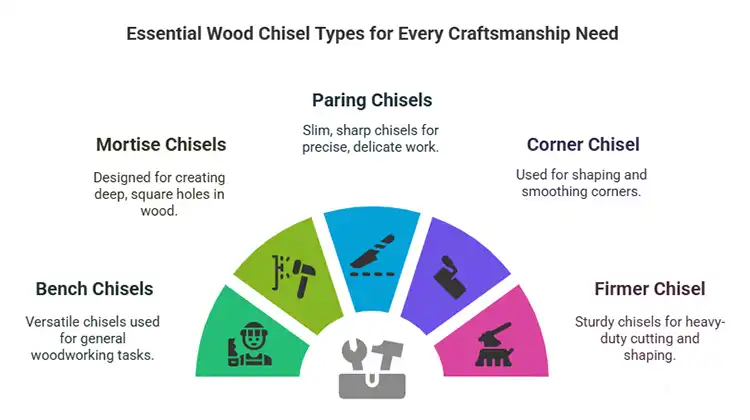
Understanding the types of woodworking chisels helps you choose the right one for your projects. Here are the most common types:
Bench Chisels
- Uses: General-purpose tasks like peeling and light chopping.
- Features: Bevel-edged blades (1/4” to 2”), durable hardwood handles.
Mortise Chisels
- Uses: Cutting deep mortises for joinery.
- Features: Thick, square blades to withstand mallet strikes.
Paring Chisels
- Uses: Shaving thin layers for smooth finishes.
- Features: Long, thin blades for precision.
Corner Chisel
- Uses: Cleaning out corners in mortises.
- Features: L-Shaped Blade, Ideal for Squaring Mortises.
Firmer Chisel
- Uses: Heavier tasks, Square-edged
- Feature: Thick, Rectangular Cross-Section Blade.
Anatomy of a Chisel
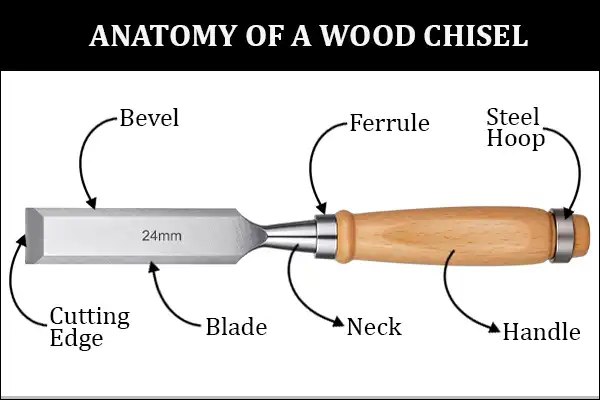
- Blade: High-carbon steel (durable) vs. chromium-vanadium (stain-resistant).
- Handle: Wood (traditional), polypropylene (shock-absorbent).
- Tang & Ferrule: Full tang for strength; ferrule prevents splitting.
Common Uses For Various Tasks
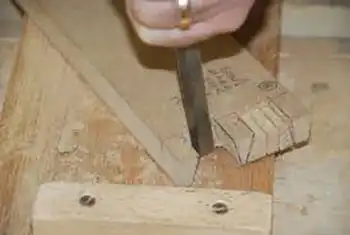
- Joinery: Crafting dovetails and mortise-and-tenon joints.
- Carving: Detailing sculptures or decorative edges.
- Paring: Smoothing uneven surfaces.
Pro Tip: Pair chisels with a mallet for heavy-duty tasks or use hand pressure for delicate work.
How to Choose the Right Wood Chisel?

When choosing, consider the following:
Blade Material:
- High-carbon steel: Holds a sharp edge longer
- Chrome-vanadium: Resists corrosion
Handle Type:
- Wooden handles: Classic and absorb shock well
- Plastic or rubber handles: Durable and often cheaper
Bevel Edge:
- Standard bevel: For general tasks
- Narrow bevel: For tight, detailed work
Avoid These Errors. Check our guide, 5 Mistakes to Avoid When Buying a Wood Chisel.
Top Wood Chisel Brands & Recommendations

- Budget: Stanley FatMax (durable, under $40).
- Mid-Range: Narex Richter (precision-ground, $100/set).
- Premium: Lie-Nielsen (hand-forged, $150+).
Best Wood Chisels for Different Projects
It depends on your project, what you’re building:
- DIY Repairs: A standard bench chisel set will do.
- Furniture Making: Opt for high-carbon steel with wooden handles.
- Joinery Work: Mortise chisels or paring chisels are best.
Top Brands to Consider:
- Narex (great value and quality)
- Stanley (reliable for all levels)
- Irwin (affordable and durable)
Quick Tip: Always check if the set includes a sharpening stone or case for added value.
Related: Best Wood Chisels for Beginners & Pros (2025 Buying Guide)
Wood Chisel Sets vs Individual Chisels
Should you buy a set or individual chisels?
Buy a Set If:
- You’re starting out
- You work on varied projects
Buy Individually If:
- You need specialized tools
- You want to upgrade specific pieces
Tips for Using Like a Pro
- Keep It Sharp: Dull chisels are dangerous and inefficient
- Work With the Grain: Always chisel along the wood grain
- Use a Mallet: Wooden or rubber mallets prevent handle damage
- Clap Your Work: Safety first—always secure the wood
Tutorial: How to Sharpen a Wood Chisel (Step-by-Step)
Maintaining Your Chisels
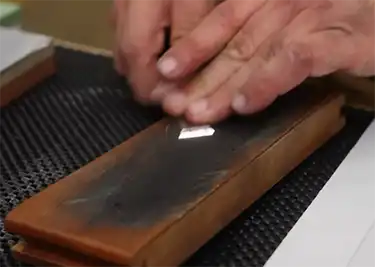
- Sharpening: Use a 1000/6000 grit whetstone; maintain a 25° bevel.
- Storage: Magnetic strips or leather rolls to prevent rust.
Final Thoughts
If you’re new to wood chisels or looking to upgrade, knowing the basics can help you choose wisely. Start with versatile options like bench chisels, keep them sharp, and pick quality tools that suit your skill level.
Let me know if you’d like a version tailored more for beginners or pros!
FAQs
Can I use a cold chisel for woodworking?
No, cold chisels are for metal and may damage wood.
What does a wood chisel look like?
A sharp, flat metal blade with a wooden or plastic handle.
What type of hammer do I use with a wood chisel?
Use a wooden mallet or a rubber mallet to avoid damaging the chisel handle.
How to chisel wood without a chisel?
Use a flathead screwdriver and a hammer as an alternative for light carving or shaping.
Related Article:
- How to Use a Woodworking Chisel: Step-by-Step Techniques for Precision
- Narex Chisels Review: Best Value Woodworking Chisels in 2025
- Best 10 Milwaukee Cutting Tools: The Perfect Companion for Your DIY Projects
- The 5 Best Makita Rotary Hammer: Dominate Your Projects 2024
- 14 Different Types of Bricklaying Tools (How to Use Them) in 2024
- 33 Different Types of Wrenches in the USA | How to Use Them?







